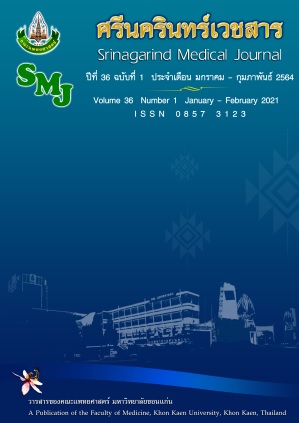Epidemiology of Eye Diseases in Handi-capped Inmates, Ubon Ratchathani Province
Abstract
โรคทางตาที่พบบ่อยในผู้ต้องขังพิการ จังหวัดอุบลราชธานี
ศิริพงษ์ สิระมนต์*, ลติพร อุดมสุข, วิรรัฐ จินาทองไทย
วิทยาลัยแพทยศาสตร์และการสาธารณสุข มหาวิทยาลัยอุบลราชธานี อำเภอวารินชำราบ จังหวัดอุบลราชธานี 34190
หลักการและวัตถุประสงค์: ตาบอดและความบกพร่องทางการมองเห็นเป็นปัญหาระดับนานาชาติ สาเหตุส่วนใหญ่ป้องกันได้ ผู้ต้องขังพิการเป็นผู้ที่ถูกจำกัดอิสรภาพแต่ควรได้รับการดูแลสุขภาพต่อเนื่อง การศึกษาความชุกโรคตาอาจทำให้สามารถวางแผนการคัดกรองและการดูแลผู้ป่วยโรคตาแบบองค์รวมให้แก่ผู้ต้องขังพิการได้อย่างมีประสิทธิภาพต่อไป
วิธีการศึกษา: เป็นการศึกษาเชิงพรรณนาโดยเก็บข้อมูลจากแบบสอบถาม ตรวจค่าสายตา และตรวจตาผู้ต้องขังพิการ ณ เรือนจำกลาง จังหวัดอุบลราชธานี ระหว่างเดือนกุมภาพันธ์ ถึง มีนาคม 2563
ผลการศึกษา: ผู้ต้องขังพิการทั้งหมด 60 ราย ส่วนใหญ่เป็นผู้พิการทางการเคลื่อนไหว 58 ราย (ร้อยละ 96.67) พบความบกพร่องการมองเห็นระยะไกล 16 ราย (ร้อยละ 26.67) สาเหตุที่พบบ่อยคือต้อกระจกและค่าสายตาผิดปกติ ในผู้ที่อายุตั้งแต่ 35 ปีขึ้นไปพบความบกพร่องการมองเห็นระยะใกล้ 18 ราย (ร้อยละ 39.1) อาการตาแห้งพบได้บ่อยและสอดคล้องกับความผิดปกติของผิวตา เช่นต้อลม ต้อเนื้อ การติดสีผิดปกติของเยื่อบุตาและกระจกตา คิดเป็นร้อยละ 98.33, 35 และ 75 ตามลำดับ
สรุป: ความบกพร่องทางการมองเห็นและโรคตาพบได้บ่อย จำเป็นต้องได้รับการดูแลโดยทีมสหวิชาชีพ เจ้าหน้าที่เรือนจำและจักษุแพทย์ การตรวจวัดระดับสายตา การคัดกรองโรคตาในเรือนจำที่มีประสิทธิภาพและการส่งต่อพบจักษุแพทย์เป็นสิ่งจำเป็น โรคผิวตาเป็นสิ่งที่ต้องตระหนักในผู้ต้องขังพิการที่มีความผิดปกติทางการมองเห็น
คำสำคัญ: ผู้ต้องขังพิการ; ความบกพร่องทางการมองเห็น; โรคตา; โรคผิวตา; เรือนจำ
Background and objectives: Blindness and vision impairment (VI) are a global problem that the causes of the VI are usually preventable. Handi-capped inmate (HI) has their freedom restricted, however, a proper healthcare should not be restricted. Epidemiological study about eye diseases may be useful for planning the effective screening program and comprehensive eye care in HIs.
Methods: A descriptive analysis using a data from questionnaires, refractive values and comprehensive eye exam in HIs at the central prison, Ubon Ratchathani province was done between February - March 2020. Results: Sixty HIs in this study, which 58 HIs had physical disability (96.67%). Sixteen HIs had distant VI (26.67%), which common causes were cataract and refractive error. HIs whom aged 35 years old and older had near VI about 18 cases (39.1%). Dry eye symptoms were commonly found which compatible with ocular surface abnormalities e.g. pinguecula, pterygium and abnormal conjunctival and corneal fluorescein staining were 98.33%, 35% and 75%, respectively.
Conclusion: VI and eye diseases were commonly found in HIs which should be received a comprehensive eye care from public health team, prison staff and ophthalmologist. Effective visual acuity testing, eye disease screening in prison and referring to ophthalmologist are necessary. Ocular surface diseases should be concerned in HIs with vision disturbance.
Keywords: handicapped inmate; vision impairment; eye disease; ocular surface disease; prison


